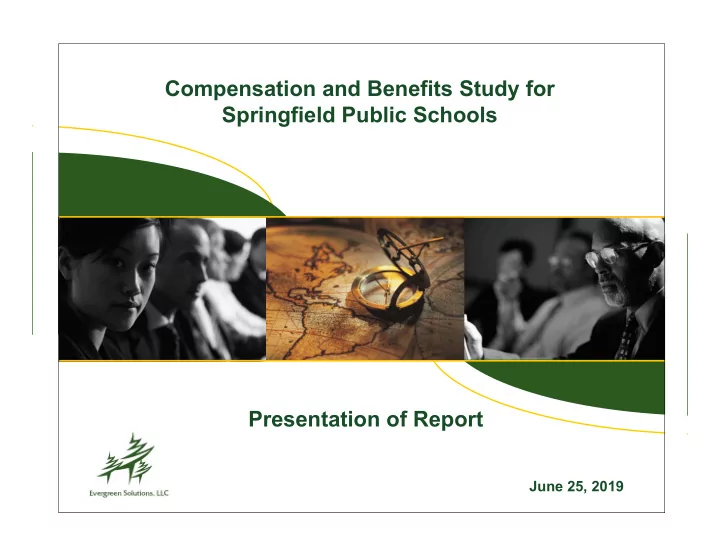

Compensation and Benefits Study for Springfield Public Schools Presentation of Report June 25, 2019
Agenda • Study Process/Goals • Outreach Summary • Assessment of Current Conditions • Market and Benefit Surveys • Recommendations • Questions 1
Study Process • Study Initiation and Data Collection • Outreach and Orientation Sessions – Chapter 2 • Analysis of Current Conditions – Chapter 3 • Market Salary and Benefits Surveys – Chapters 4 and 5 • Job Assessment Tool (JAT) and Classification Scoring – Chapter 6 • Recommendations – Chapter 6 2
Study Goals • Review internal and external (market analysis) equity structure by which classified and certificated employees are compensated. • Conduct a Benefits Study of offerings of Springfield Public Schools as compared to market. • Provide recommendations and cost analysis of any necessary improvements to Springfield Public Schools compensation, classification, and benefits plan. 3
Study Initiation and Outreach • Study Initiation – August 2018 • Four Orientation Sessions – Week of September 18, 2018 – 110 employees attended • Video link for those employees who could not attend orientation sessions • 44 Focus Groups conducted with 370 Employees 4
Study Initiation and Outreach • Job Assessment Tool (JAT) – September 21 – October 19, 2018 Supervisor’s and HR Review – October – February 2019 • 1,918 Employee Completions (58%) • 1,554 Supervisor Completions (44%) • 27 Management Issue Tools (MITs) 5
Outreach Summary • Employees enjoy the working environment in Springfield Public Schools, share genuine passion and appreciation for working with students, enjoy camaraderie with co‐workers, and have the support of supervisors. • Many employees expressed concerns that the current compensation structure pays them less than in peer school districts. • Several employees provided examples of internal equity, compression issues, and concern with the lack of promotional opportunities. • Employees shared various issues with classifications and position titles. 6
Assessment of Current Conditions • 6 salary tables included in the study: 321 unique job titles 3,506 employees (3,078 full‐time and 428 part‐time). • Summary Analysis: Range Spread generally set between 50 to 70 percent for best practice averages 51.2 percent in the Secretarial/Clerical salary schedule, 45.5 percent in the ESP salary schedule, 36.1 percent in the Non‐union salary schedule, 33.4 percent in the Nurses salary schedule, 48.1 percent in the Teachers salary schedule, and 43.4 percent in the Transportation salary schedule. 7
Assessment of Current Conditions Midpoint Progression generally set between 3 to 5 percent for best practice averages 6.3 percent in the Secretarial/Clerical salary schedule, 7.5 percent in the ESP salary schedule, 3.8 percent in the Non‐union salary schedule, 13.9 in the Nurses salary schedule, 10.4 percent in the Teachers salary schedule, and 12.1 percent in the Transportation salary schedule. Salary Placement the majority of employees in the Secretarial/ Clerical and ESP salary schedules are compensated above their pay grade’s midpoint, whereas employees in the Non‐union, Nurses, Teachers, and Transportation salary schedules are fairly evenly distributed around their pay grade’s midpoint. Grade Penetration the District generally maintains a healthy positive linear relationship between experience and grade penetration throughout each pay range. 8
Job Assessment Tool • Provided Data on Roles and Responsibilities by Classification • All Employees Asked to Complete • Produced Classification Scores Based on 5 Factors: Leadership Working Conditions Complexity Decision Making Relationships • Multiple Verification Steps: Employee Input, Supervisor Review, Review by Evergreen, Review by Human Resources Office Staff • Combined with Market Survey Data, allowed for Calculation of Predicted Market Values and Updating of Job Descriptions 9
Market Survey • 12 Market Peers and ERI data for private sector (Economic Research Institute data) • 221 Market Matches Made • Evergreen found that overall District salary ranges are: Non‐Exempt Positions: SPS is approximately 1.6 percent below the market minimum, 5.8 percent below the market midpoint, and 8.7 percent below the market maximum of salary ranges of benchmark positions. The average market range spread across the salary ranges of all surveyed non‐exempt positions is 51.6 percent, which is broader than the 41.5 percent among non‐exempt benchmarked classifications. 10
Market Survey (Cont’d) Exempt Positions: The average market range spread across the salary ranges of all surveyed exempt positions is 37.4 percent, which is slightly narrower than the 39.8 percent among exempt benchmarked classifications. SPS is approximately 5.9 percent above the market minimum, 6.9 percent above the market midpoint, and 7.6 percent above the market maximum of salary ranges of benchmark positions. Stipends: SPS offers similar stipends and supplements compared to the market for common programs. SPS appears to offer many additional supplements due to the size and complexity of the District. 11
Benefits Survey • Overall, SPS was found to be at or above the market in terms of benefits provided. • When single benefits were analyzed in isolation, many of the District's offerings appeared more generous than those offered by peers. • Health insurance premiums paid by SPS are higher than peers and employee out of pocket premiums are lower than peers, and as compared to other peer districts, the annual deductible for individual/family coverage is lower for SPS employees. 12
Recommendations • Eleven (11) Recommendations to Address Compensation and Classification Findings • Cost Implementation Options Provided • Recommendations Designed to Bring Springfield Public Schools to Market 13
Recommendations (Cont’d) RECOMMENDATION 1: Adopt the proposed new salary schedules to strengthen the SPS salary structure. RECOMMENDATION 2: Adopt the new classification titles proposed by Evergreen, and place appropriate employees into appropriate classifications. RECOMMENDATION 3: Adopt the implementation option that is most appropriate for Springfield Public Schools. 14
Implementation Options 15
Recommend
More recommend